In the modern, digitally-first world, delivery apps are now essential for companies of all kinds. A delivery app is more than just a convenient tool for small businesses; it’s a way to reach a wider audience, increase revenue, and give great customer service.
It doesn’t have to be too difficult or costly to Make a delivery app specifically for your small business. With the correct strategy, you can create an app that meets your specific requirements and makes a name for itself in a crowded industry.
We’ll take you step-by-step through the whole process of creating a delivery app for small businesses in this tutorial, from planning and development to launch and beyond.
Why Small Businesses Need a Delivery App
Before diving into the “how,” let’s explore why having a delivery app can transform your small business:
- Expanded Reach: Delivery apps allow you to serve customers beyond your local area.
- Enhanced Convenience: Customers can order directly from their smartphones anytime, anywhere.
- Increased Sales: The ease of ordering often encourages repeat purchases and higher order values.
- Brand Visibility: A well-designed app reinforces your brand and builds customer loyalty.
- Streamlined Operations: Automated order processing and tracking improve efficiency.
Steps to Make a Delivery App for Small Businesses
1. Define Your Business Goals and Requirements
Start by understanding your business needs and setting clear goals. Consider:
- Target Audience: Who will use your app? (e.g., local customers, niche markets)
- Core Features: What functionalities are essential? (e.g., order tracking, payment gateway)
- Budget: How much can you invest in app development?
2. Conduct Market Research
Analyze your competitors and identify what works for them. Look for:
- Popular features in similar apps
- Customer pain points your app can solve
- Market trends and innovations
3. Choose the Right Development Approach
You have several options for creating your delivery app:
- Hire a Professional Developer or Team: Ideal for custom apps tailored to your needs.
- Use App Builders: cost-effective and fast, but with limited customization.
- Partner with a Development Company: A middle ground offering expertise and scalability.
4. Essential Features to Include
Your app should balance functionality with simplicity. Key features include:
Customer Side:
- User-friendly registration and login
- Product/service catalog with search and filters
- Real-time order tracking
- Multiple secure payment options
- Push notifications for updates and promotions
Business/Admin Side:
- Order management and tracking dashboard
- Customer analytics and reports
- Inventory management tools
- Support for discounts and promotional campaigns
Delivery Driver Side (if applicable):
- Route optimization for efficient deliveries
- Real-time updates on assigned orders
- Driver performance tracking
5. Select the Technology Stack
The tech stack determines your app’s performance and scalability. Common tools include:
- Front-End Development: React Native, Flutter (cross-platform)
- Back-End Development: Node.js, Django, or Laravel
- Database: Firebase, MongoDB, or MySQL
- Payment Gateway Integration: Stripe, PayPal, or Razorpay
6. Develop a Minimum Viable Product (MVP)
An MVP is a scaled-down version of your app with essential features. Launching an MVP allows you to:
- Test app functionality with real users
- Gather feedback for improvements
- Save time and resources before full-scale development
7. Focus on User-Friendly Design
The design of your app can make or break its success. Ensure that:
- The interface is clean and intuitive.
- Navigation is straightforward.
- The branding reflects your business identity.
8. Test and Debug Thoroughly
Before launching, test your app extensively to identify and fix bugs. Perform:
- Functional testing: ensures all features work as intended.
- Performance testing confirms the app’s speed and responsiveness.
- Compatibility testing: Checks performance across different devices and operating systems.
9. Launch and Promote Your App
Once your app is ready:
- Publish it on app stores (Google Play, Apple App Store).
- Announce the launch through email campaigns, social media, and local marketing efforts.
- Encourage reviews and ratings to build credibility.
10. Monitor, Update, and Scale
Your app’s journey doesn’t end with its launch. Regular updates and maintenance are crucial to:
- Add new features based on user feedback
- Keep up with technology trends
- Ensure app security and reliability
Budgeting for a Delivery App
Since small enterprises frequently have limited resources, cost-effectiveness is essential. An approximate breakdown of app development expenses is provided below:
- Basic App: $5,000–$15,000 (simple features, single platform)
- Intermediate App: $15,000–$50,000 (additional features, cross-platform)
- Advanced App: $50,000+ (custom features, high scalability)
Tips to minimize costs:
- Start with an MVP.
- Use open-source technologies.
- Outsource to cost-effective regions.
Conclusion
For your small business, developing a delivery app is a wise investment that can encourage expansion and open up new avenues for growth. You can create an app that improves user pleasure, speeds up processes, and broadens your audience by working with skilled developers or by utilizing the appropriate resources.
